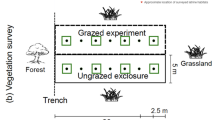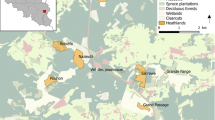Abstract
Permanent grasslands are an important habitat for insect communities, including pollinator populations which are in pan-European decline. Here, we investigated the benefits of temporarily excluding sheep from pastures on butterfly (Lepidoptera: Rhopalocera and Zygaenidae) and bumblebee (Hymenoptera: Bombidae) communities in two semi-natural grasslands differing in soil fertility and surrounding landscapes. We compared the impact of continuous grazing against rotational grazing (RG) at the same stocking rate but in which a subplot was excluded from the rotation during the main flowering period. We predicted that the diversity of flower-visiting insect community would be improved by RG due to the preservation of flower-rich patches and the maintenance of sward heterogeneity. Benefits of RG management were mainly evidenced on bumblebee density and species richness, with some additional effects on local density of butterflies during the subplot-exclusion period. Temporarily excluding sheep from pastures during peak flowering could thus offer an opportunity to preserve the diversity of flower-visiting insects, in spite of weaker benefits than could have been expected from previous surveys with cattle.





Similar content being viewed by others
References
Bachelard P, Fournier F (2008) Papillons du Puy de Dôme. Atlas écologique des Rhopalocères et Zygènes, Revoir, Nohanent
Bardat J, Bioret F, Boniteau M, Boullet V, Delpech R, Gehu JM, Haury J, Lacoste A, Rameau JC, Royer JM, Roux G, Touffet J (2004) Prodrome des Végétations de France. Publications scientifiques du Muséum National d’Histoire Naturelle, Paris
Barthram GT (1986) Experimental techniques: the HFRO sward stick. Biennial report, 1984–85, Hill Farming Research Organization, Penicuik, pp 29–30
Biedermann R, Achtziger R, Nickel H, Stewart AJA (2005) Conservation of grassland leafhoppers: a brief review. J Insect Conserv 9:229–243. doi:10.1007/s10841-005-0531-z
Braun-Blanquet J (1932) Plant sociology, the study of plant communities. McGraw-Hill, New-York
Carvell C (2002) Habitat use and conservation of bumblebees (Bombus spp.) under different grassland management regimes. Biol Conserv 103:33–49. doi:10.1016/S0006-3207(01)00114-8
Clarke KR, Somerfield PJ, Chapman MG (2006) On resemblance measures for ecological studies, including taxonomic dissimilarities and a zero-adjusted Bray-Curtis coefficient for denuded assemblages. J Exp Mar Biol Ecol 330:55–80. doi:10.1016/j.jembe.2005.12.017
Crawley MJ (2007) The R Book. Wiley, Chichester
Dahms H, Mayr S, Birkhofer K, Chauvat M, Melnichnova E, Wolters V, Dauber J (2010) Contrasting diversity patterns of epigeic arthropods between grasslands of high and low agronomic potential. Basic Appl Ecol 11:6–14. doi:10.1016/j.baae.2009.06.004
Dramstad W, Fry D (1995) Foraging activity of bumblebees (Bombus) in relation to flower resources on arable land. Agric Ecosyst Environ 53:123–135. doi:10.1016/0167-8809(94)00561-R
Dumont B, Carrère P, Ginane C, Farruggia A, Lanore L, Tardif A, Decuq F, Darsonville O, Louault F (2011) Plant-herbivore interactions affect the initial direction of community changes in an ecosystem manipulation experiment. Basic Appl Ecol 12:187–194. doi:10.1016/j.baae.2011.02.011
Farruggia A, Dumont B, Scohier A, Leroy T, Pradel P, Garel JP (2012) An alternative grazing management strategy designed to favour butterflies in permanent grassland. Grass Forage Sci 67:136–149. doi:10.1111/j.1365-2494.2011.00829.x
Franzén M, Nilsson SG (2008) How can we preserve and restore species richness of pollinating insects on agricultural land? Ecography 31:698–708. doi:10.1111/j.1600-0587.2008.05110.x
Goffart P, Schtickzelle N, Turlure C (2010) Conservation and management of the habitats of two relict butterflies in the Belgian Ardennes: Proclossiana eunomia and Lycaena helle. In: Habel JC, Assmann T (eds) Relict species—phylogeography and conservation biology. Springer, Berlin, pp 357–370
Gotelli N, Colwell R (2001) Quantifying biodiversity: procedures and pitfalls in measurement and comparison of species richness. Ecol Lett 4:379–391. doi:10.1046/j.1461-0248.2001.00230.x
Goulson D (2010) Bumblebees, behaviour, ecology, and conservation. Oxford University Press, New York
Grime JP, Hodgson JG, Hunt R (1988) Comparative plant ecology. A Functional Approach to Common British Species, Unwin Hyman
Hanley ME, Franco M, Pichon S, Darvill B, Goulson D (2008) Breeding system, pollinator choice and variation in pollen quality in British herbaceous plants. Funct Ecol 22:592–598. doi:10.1111/j.1365-2435.2008.01415.x
Jacobs J (1974) Quantitative measurements of food selection. A modification of the forage ratio and Ivlev’s electivity index. Oecologia 14:413–417
Kruess A, Tscharntke T (2002) Grazing intensity and the diversity of grasshoppers, butterflies and trap-nesting bees and wasps. Conserv Biol 16:1570–1580. doi:10.1046/j.1523-1739.2002.01334.x
Lye CG, Kaden JC, Park KJ, Goulson D (2010) Forage use and niche partitioning by non-native bumblebees in New Zealand: implications for the conservation of their populations of origin. J Insect Conserv 14:607–615. doi:1007/s10841-010-9287-1
Morris MG, Clarke RT, Rispin WE (2005) The success of a rotational grazing system in conserving the diversity of chalk grassland Auchenorrhyncha. J Insect Conserv 9:363–374. doi:10.1007/s10841-005-8825-8
Öckinger E, Eriksson AK, Smith HG (2006) Effects of grassland abandonment, restoration and management on butterflies and vascular plants. Biol Conserv 133:291–300. doi:10.1016/j.biocon.2006.06.009
Olff H, Ritchie ME (1998) Effects of herbivores on grassland plant diversity. Trends Ecol Evol 13:261–265. doi:10.1016/S0169-5347(98)01364-0
Pasta DJ (2011) Those confounded interactions: building and interpreting a model with many potential confounders and interactions. In: Statistics and Data Analysis SAS Global Forum 2011, paper 347
Pollard E, Yates TJ (1993) Monitoring Butterflies for Ecology and Conservation. Chapman and Hall, London
Potts SG, Biesmeijer JC, Kremen C, Neumann P, Schweiger O, Kunin WE (2010) Global pollinator declines: trends, impacts and drivers. Trends Ecol Evol 25:345–353. doi:10.1016/j.tree.2010.01.007
Prŷs-Jones OE, Corbet SA (1991) Bumblebees. Naturalists’ Handbooks. The Richmond Publishing Co, Slough
Rasmont P, Terzo M (2010) Catalogue et clé des sous-genres et espèces du genre Bombus de Belgique et du nord de la France (Hymenoptera, Apoidea). Université de Mons, Laboratoire de Zoologie
Rook AJ, Dumont B, Isselstein J, Osoro K, WallisDeVries MF, Parente G, Mills J (2004) Matching type of livestock to desired biodiversity outcomes in pastures: a review. Biol Conserv 119:137–150. doi:10.1016/j.biocon.2003.11.010
Scohier A, Dumont B (2012) How do sheep affect plant communities and arthropod populations in temperate grasslands? Animal 6:1129–1138. doi:10.1017/S1751731111002618
Sebastià MT, De Bello F, Puig L, Taull M (2008) Grazing as a factor structuring grasslands in the Pyrenees. Appl Veg Sci 11:215–222. doi:10.3170/2008-7-18358
Shochat E, Wolfe DH, Patten MA, Reinking DL, Sherrod SK (2005) Ecological traps in isodars: effects of tallgrass prairie management on bird nest success. Oikos 111:159–169. doi:10.1111/j.0030-1299.2005.13907.x
Sjödin NE (2007) Pollinator behavioural responses to grazing intensity. Biodivers Conserv 16:2103–2121. doi:0.1007/s10531-006-9103-0
Sjödin NE, Bengtsson J, Ekbom B (2008) The influence of grazing intensity and landscape composition on the diversity and abundance of flower-visiting insects. J Appl Ecol 45:763–772. doi:10.1111/j.1365-2664.2007.01443.x
Stewart GB, Pullin AS (2008) The relative importance of grazing stock type and grazing intensity for conservation of mesotrophic ‘old meadow’ pasture. J Nat Conserv 16:175–185. doi:10.1016/j.jnc.2008.09.005
Thomas JA, Telfer MG, Roy DB, Preston CD, Greenwood JJD, Asher J, Fox R, Clarke RT, Lawton JH (2004) Comparative losses of British butterflies, birds, and plants and the global extinction crisis. Science 303:1879–1881. doi:10.1126/science.1095046
Tolman T, Lewington R (1997) Butterflies of Britain and Europe. Harpers-Collins Publishers, London
Van Swaay C, Warren M, Lois G (2006) Biotope use and trends of European butterflies. J Insect Conserv 10:189–209. doi:10.1007/s10841-006-6293-4
WallisDeVries MF, Poschlod P, Willems JH (2002) Challenges for the conservation of calcareous grasslands in northwestern Europe: integrating the requirements of flora and fauna. Biol Conserv 104:265–273. doi:10.1016/S0006-3207(01)00191-4
WallisDeVries MF, Parkinson AE, Dulphy JP, Sayer M, Diana E (2007) Effects of livestock breed and grazing intensity on biodiversity and production in grazing systems. 4. Effects on animal diversity. Grass For Sci 62:185–197. doi:10.1111/j.1365-2494.2007.00568.x
Woodcock BA, Pywell R, Roy DB, Rose R, Bell D (2005) Grazing management of calcareous grasslands and its implications for the conservation of beetle communities. Biol Conserv 125:192–202. doi:10.1016/j.biocon.2005.03.017
Yoshihara Y, Chimeddorj B, Buuueibaatar B, Lhaquasuren B, Takatsuki S (2008) Effects of livestock grazing on pollination on a steppe in Eastern Mongolia. Biol Conserv 14:2376–2386. doi:10.1016/j.biocon.2008.07.004
Acknowledgments
The authors thank Philippe Bachelard and Benjamin Calmont (Société d’Histoires Naturelles Alcide-d’Orbigny) for insect counts and identification. We are also grateful to Mickael Bernard and Pascal Payard from the INRA UERT Unit for providing us with excellent research facilities, and to Laurent Lanore and student Manon Bonnot for help with vegetation measurements. The research leading to these results has received funding from the European Community’s Seventh Framework Program (FP7/2007-2013) under the grant agreement n° FP7-244983 (MULTISWARD).
Author information
Authors and Affiliations
Corresponding author
Rights and permissions
About this article
Cite this article
Scohier, A., Ouin, A., Farruggia, A. et al. Is there a benefit of excluding sheep from pastures at flowering peak on flower-visiting insect diversity?. J Insect Conserv 17, 287–294 (2013). https://doi.org/10.1007/s10841-012-9509-9
Received:
Accepted:
Published:
Issue Date:
DOI: https://doi.org/10.1007/s10841-012-9509-9




